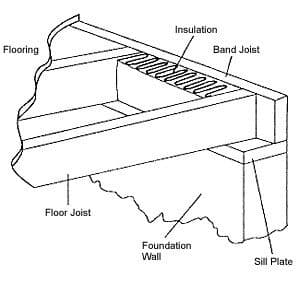What Are the Problems with Sagging Floor Repairs?

When you have sagging floors, it means one or more of the wooden components of your floor structure is damaged. If you’re not familiar with what these components are, we review all the pieces and parts (and typical repair methods) in this article.
Acculevel has been repairing foundations and waterproofing basements and crawl spaces since our start in 1996. We’re a family-owned and operated company serving Indiana and the surrounding states, and have restored health and stability to over 30,000 homes. Homeowner education is a vital part of our company philosophy and we believe everyone deserves fair and honest answers to their questions. Our goal is to provide five star customer service to every homeowner, and direct communication is part of that.
In this article, we’re going to dive into the possible pitfalls that you may encounter when having your sagging floor repaired. Because the repair options are diverse, we’ve divided the issues into three primary categories: center beam and jacks, joists and outside components, and the limited longevity of the repairs.
For Main Beam & Jacks
If your floor is sagging in the center of your home, this usually indicates that either your main beam is failing, or that the columns supporting your beam are damaged. Depending on which is true- and it can be both- we recommend replacing the wooden center beam with a steel I-beam and the columns with steel adjustable jacks.
Slow and Steady is the Best Method
These actions repair the damage and restore stability to your floor. However, they are not instant cures. One of the most common issues we see with these repairs is impatience. Homeowners often want the floor lifted back to its original position in the home, and this is an understandable desire. That does not mean it’s 100% possible.
 This photo was taken by an Acculevel team member after installing jacks to shore up a center beam in a crawl space.
This photo was taken by an Acculevel team member after installing jacks to shore up a center beam in a crawl space.
Wood is not a highly flexible material, so it takes a long time for it to lean, slope, or dip in shape. It’s slow to curve, so it’s slow to straighten. If you try to shove it back into position, you can actually do more harm than good.
At Acculevel, if we need to install adjustable jacks, we warranty them for 2 years, covering a total of 3 gradual adjustments. This allows us to return, approximately every 6 months, and raise the beam a bit each time. Raising the beam at a more gradual pace increases the likelihood of lift without damage to the floor or other connected parts.
Patience is Key
Often, when your flooring sags or slopes, other problems occur. There may be gaps between your kitchen cabinets and the ceiling, or cracks in the paint or drywall. I understand that you want to fix these problems- they’re exactly the unsightly symptoms that prompted you to investigate your sagging floor in the first place!
But if you fix this as soon as the initial work is done, or after the first adjustment, you may be unhappy with the results.
If you patch the drywall and repaint right away, you’re not going to like it when the next adjustment creates cracks in new or additional places. Remember: wood has to be shifted gradually, or it can make more problems. So please, as hard as it may be, don’t make any significant changes until after the second or (ideally) the third adjustment.
For Other Wooden Structural Repairs
If your floor is sloping to an outside wall, this usually indicates a damaged sill plate. Floor joist issues result in uneven or bouncy floors. Since joists rest on the sill plate, the damage frequently extends to both components. (I included a diagram below, for quick and easy reference.)
 Example of a flooring structure is courtesy of NCSU.
Example of a flooring structure is courtesy of NCSU.
Unexpected Costs
The most common problem with repairing band joists, sill plates, or floor joists is that there may be more damage than originally diagnosed. It is not unusual for our crew members to start sill plate replacement, only to find that the band board (also called a band joist) also needs replacing.
The project manager who evaluated your crawl space would have inspected all of the components they could see. But things like insulation and ductwork can interfere with visibility during a preliminary inspection. If additional damages are discovered during the repair, the installation crew will notify you and your project manager. This will give you the opportunity to discuss the additional needed work before it is completed.
Flooring Structure Repairs Are Not Permanent
Wood is obviously not an indestructible substance. If it were, you wouldn’t need it reinforced or replaced, right? But making these types of repairs is a relatively short-term solution, if you don’t take any action to prevent the same problem from occurring again in the future.
If you want to maximize the longevity of the repairs, you need to address the root cause of the problem. In almost every instance, this is water. Moisture in your crawl space is the number one source of damage to the joists, beams, and other wooden components of your flooring. Damp wood is more appealing to insects like termites, which increase the rate of decay.
Moisture is also a critical ingredient for mold, mildew, and other types of biological growth. While these do less direct damage to the wood, they generate significant byproducts that reduce the air quality in your home.
 This photo was taken by an Acculevel project manager during a free estimate appointment. The joists and beams are sagging, and covered in biological growth.
This photo was taken by an Acculevel project manager during a free estimate appointment. The joists and beams are sagging, and covered in biological growth.
How Do You Extend the Life of the Repairs?
There are several ways to protect your crawl space against moisture and water damage. We provide details about each of them in the links below:
- Vapor barriers are a simple, but absolutely essential component. They cover the dirt floor of the crawl space and block most moisture and water vapors from entering.
- A waterproofing system will manage any water that intrudes into the crawl space and direct it out through a sump pump and discharge line.
- If you have significant moisture under your home, or live in an area that experiences high humidity levels, a dehumidifier is a terrific investment. It severely limits biological growth, has a tremendous impact on air quality, and will reduce your HVAC unit’s workload.
- Encapsulation is the ideal solution if you want to safely store items in the crawl space, have significant allergies or asthma, or just prefer to have the space sealed for maximum health and air quality.
Do You Have More Questions about Your Crawl Space?
We have created a Crawl Space Repair Guide for homeowners. Our goal with this guide is to address all of our customers’ frequently asked questions, explore what causes the most typical problems, and reviews the solutions to those problems. We also provide pricing for these repairs, explain how the repairs are made, and how you can prevent issues in the future.
What’s the Next Step?
If you have sagging floors that need repairs, you should contact a qualified professional contractor to evaluate your home. If you live in our service area, please contact Acculevel. We’ll schedule an appointment for you to meet with one of our knowledgeable and experienced project managers. They’ll discuss your concerns, inspect your home, and provide you with the best possible solution to keep your home healthy and in great shape for years to come.
If you do not live in our area, or if you are unsure about the questions to ask during the appointment, please start with our article on the questions to ask a contractor. The article explains why these are essential questions, what our answers are, and what responses you need to be wary of. There is also a downloadable copy of these questions available for free, to help you screen the contractors you meet.
